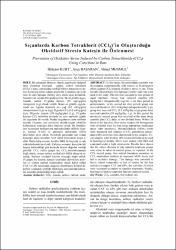Sıçanlarda karbon tetraklorit (CCl4)’in oluşturduğu oksidatif stresin kateşin ile önlenmesi
Abstract
Bu çalışmada deneysel olarak, sıçanlarda oksidatif
stres oluşturan kimyasal madde karbon tetraklorit
(CCl4)’e karşı, antioksidan özelliği bilinen kateşinin ne derece
koruyucu etkisi olduğu araştırıldı. Çalışmada üç aylık
otuz iki adet Spraque Dawley soyu erkek sıçan kullanıldı.
Sıçanlar eşit sayıda dört gruba ayrıldı. İlk on günlük uygulamada,
sadece IV.gruba kateşin (50 mg/kg/gün)
intragastrik (i.g) olarak verildi. İkinci on günlük uygulamada
ise, I.gruba (kontrol) sıvı yağ (0.2 ml/kg/gün)
intraperitoneal (i.p) ve (i.g), II.gruba CCl4 (0.2 ml/kg/gün)
(i.p), III.gruba kateşin (50 mg/kg/gün) (i.g), IV.gruba
kateşin+CCl4 belirtilen dozlarda ve aynı saatlerde günde
iki uygulama ile verildi. Madde uygulaması sona erdikten
sonraki 24.saatte, eter anestezisi altında uygun teknikler
kullanılarak karaciğer doku örnekleri alındı. Bu örneklerden
hazırlanan homojenatta malondialdehit (MDA) düzeyi,
katalaz (CAT) ve glutatyon peroksidaz (GPx)
aktiviteleri tayin edildi. Histolojik çalışmalar için alınan
karaciğer doku örnekleri %10 nötral formalinde tespit edildi.
Rutin takip sonrası kesitler H&E ile boyandı ve ışık
mikroskobunda incelendi. Çalışma sonunda, kateşinin tek
başına beklenildiği gibi kontrole benzer değerler verdiği
görüldü. CCl4 verilen grupta ise, CCl4 metabolizmasına
bağlı olarak, oluşan serbest radikallerin MDA düzeyini artırdığı,
böylece oksidatif hasarın oluştuğu tespit edildi.
IV.grupta bu hasarın, kateşin tarafından aktiviteleri artırı-
lan ve serbest radikal süpürücüleri olarak kabul edilen
CAT ve GPx tarafından, nispeten düzeltilerek kontrol de-
ğerlere yaklaştığı görüldü. Histolojik sonuçlarında kimyasal
sonuçları desteklediği tespit edildi. In this study, the antioxidants catechin was
investigated experimentally with respect to its protective
effect against CCl4-induced oxidative stress in rats. Three
months old and thirty-two Spraque Dawley male rats were
used in the study. The rats were assigned to four groups in
equal numbers. Group four received catechin (50
mg/kg/day) intragastrically (i.g) for a ten days period as
pretreatments. In the second ten days period, group one
received liquid oil (0.2 ml/kg/day) intraperitoneally (i.p),
group two received CCl4 (0.2 ml/kg/day) (i.p) group three
received catechin (50 mg/kg/day, i.g). In this period the
previously treated group four received at the same doses
catechin plus CCl4 daily in two divided doses. Within 24
hours of the last dose, liver tissue samples for homogenate
were collected from the rats using appropriate techniques
under ether anesthesia. Malondialdehide (MDA) levels
were measured and catalase (CAT), glutathione peroxidase
(GPx) activities were determined in the samples. Tissue
samples were fixed in 10% neutral formalin to be used
in histological studies. Slices were stained with H&E and
examined under a light microscobe. Results have shown
that the values obtained in only catechin treatment groups
were close to values in control group, as expected. In the
CCl4 treated group, free radical formation secondary to
CCl4 metabolism resulted in increased MDA levels and
led to oxidative damage. This damage was corrected to
levels almost comparable to that of control by the free
radical scavengers CAT and GPx, the activities of which
were increased secondary to catechin treatments. Finally,
histological studies supported that our chemical results.
Source
Afyon Kocatepe Üniversitesi, Kocatepe Tıp DergisiVolume
5Issue
2Collections
- Makaleler [452]



















